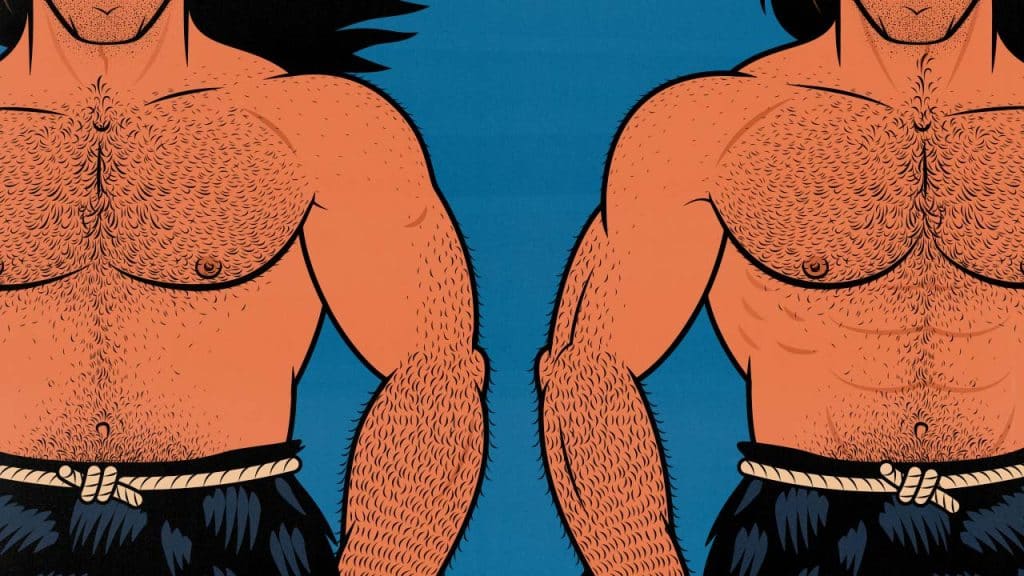
Reverse Bulking: How to Maintain Your Gains After Bulking
Reverse bulking is for people who are sick of eating so much food but want to maintain the gains they made while bulking. I haven’t seen this discussed anywhere else, which is strange, given how well it works. I’ve been using this method on myself and clients for over a decade now, but we never named it, and I don’t think we’ve ever mentioned it our articles.
The idea is simple: most skinny guys hate eating enormous amounts of food. When they finish bulking, they want to go back to eating like regular human men again. But they’re worried that if they do, they’ll lose all their hard-won gains. That’s where reverse bulking comes in.
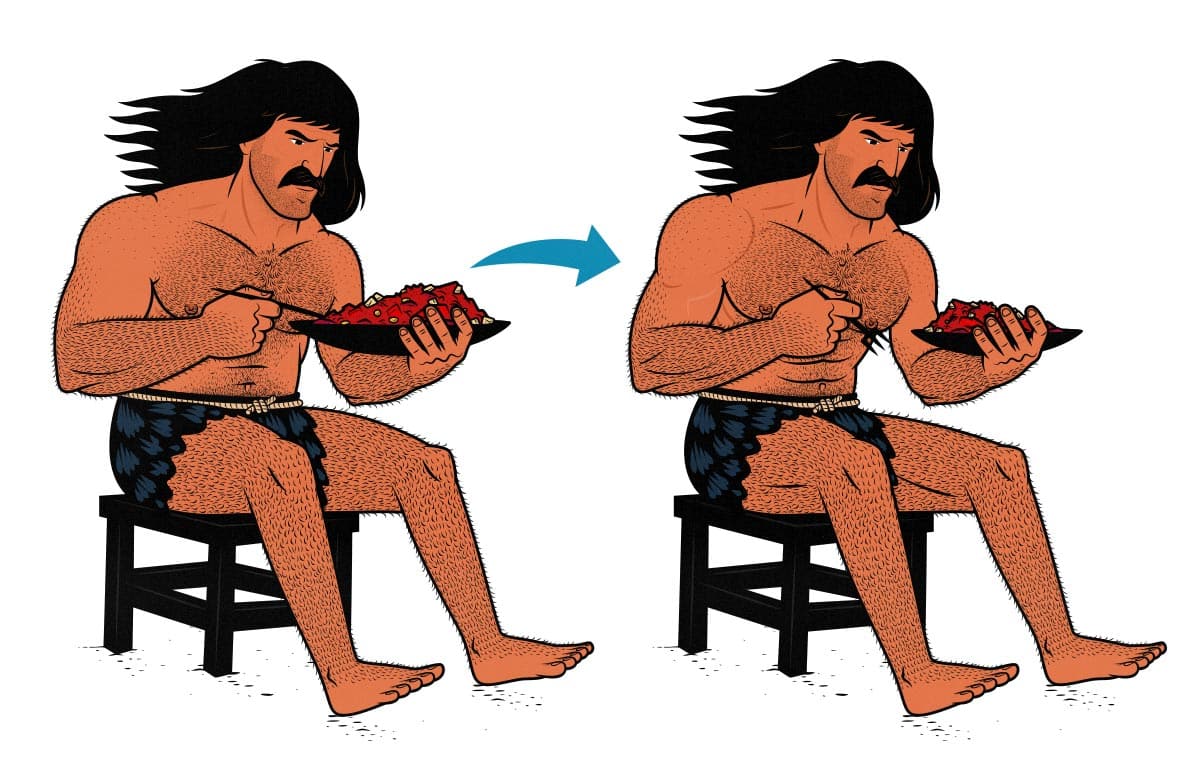
What’s Reverse Bulking?
I haven’t ever heard anyone talking about reverse bulking, perhaps because it’s a phenomenon unique to us naturally thin guys. If you’re familiar with the bodybuilding concept of reverse dieting, this has the same rejuvenating spirit, but it’s coming from the other direction.
- Reverse Dieting: when you finish cutting and begin listening to your appetite again, regaining some of the weight you lost and climbing back up to a healthier body-fat percentage. For example, going from 8% to 12% body fat.
- Reverse Bulking: when you finish bulking and begin listening to your appetite again, letting yourself lose a bit of weight, keeping your muscles, and reclaiming any leanness you lost.
Whether you’re reverse dieting or reverse bulking, the idea is to return to a more intuitive and enjoyable way of eating and living. It’s a method for maintaining your gains in a healthy and sustainable way.
However, reverse bulking won’t work for everyone. It hinges on a trait that’s somewhat unique to us naturally thin guys. Even then, it only works for about 60–90% of us. Let’s delve deeper into the nuance.
The Problem of the Adaptive Metabolism
In a landmark study by Levine and colleagues, researchers put men in a metabolic ward, giving them complete control over how many calories the participants ate and what activities they engaged in. The researchers began by determining how many calories these men ate and burned. Then they overfed them by 1,000 extra calories each day.
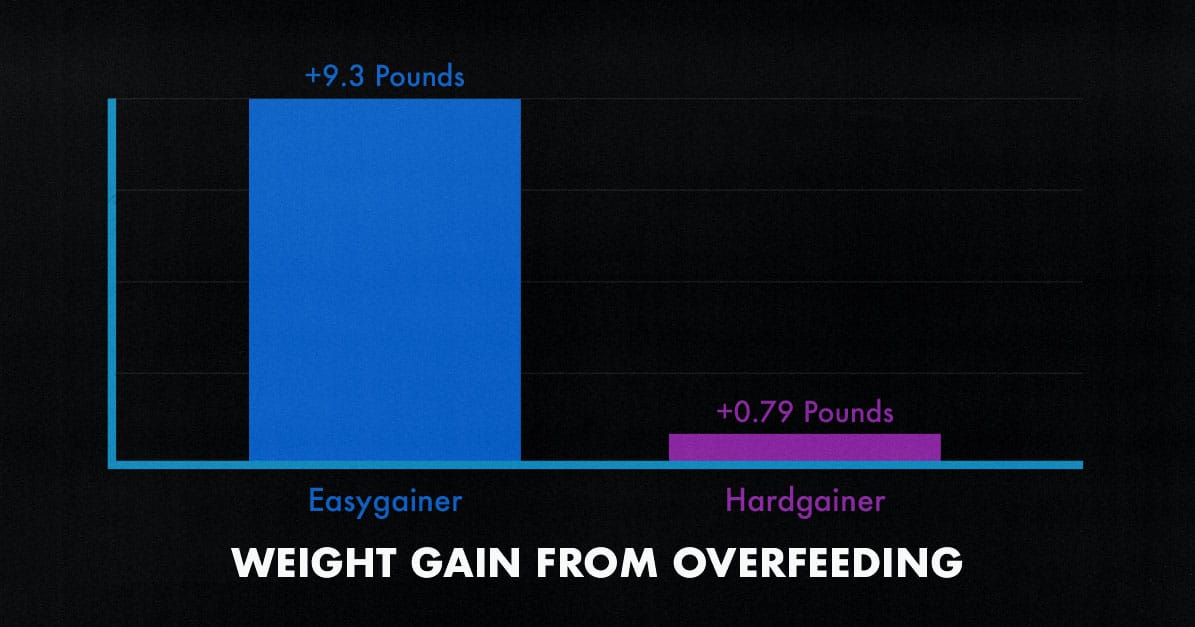
As you’d expect, the extra food helped the guys gain weight. However, there was a huge variance in the amount of weight they gained. One guy gained a whopping 9.3 pounds. Another gained only 0.79 pounds (study). Said another way, even though all of these guys were being overfed by the same amount, and even though they were doing the amount of exercise, some guys gained 10x more weight than others.
The researchers discovered that some people have especially adaptive metabolisms. When you feed them more food, their metabolisms increase, burning away most of the extra calories. These guys were dubbed “hardgainers.” Their thinness was genetic. The same is true for many of us.
Understand, that doesn’t mean it’s impossible for us to gain weight. If you’ve just finished a successful bulk, you’ve already found a way. But that way is often difficult.
If you’re like me, your metabolism increases as you delve deeper into a bulk. By the time you finish, you may need to shovel down entire mountain ranges of food to merely maintain your weight. It’s not sustainable. We need a way to calm our metabolisms back down.
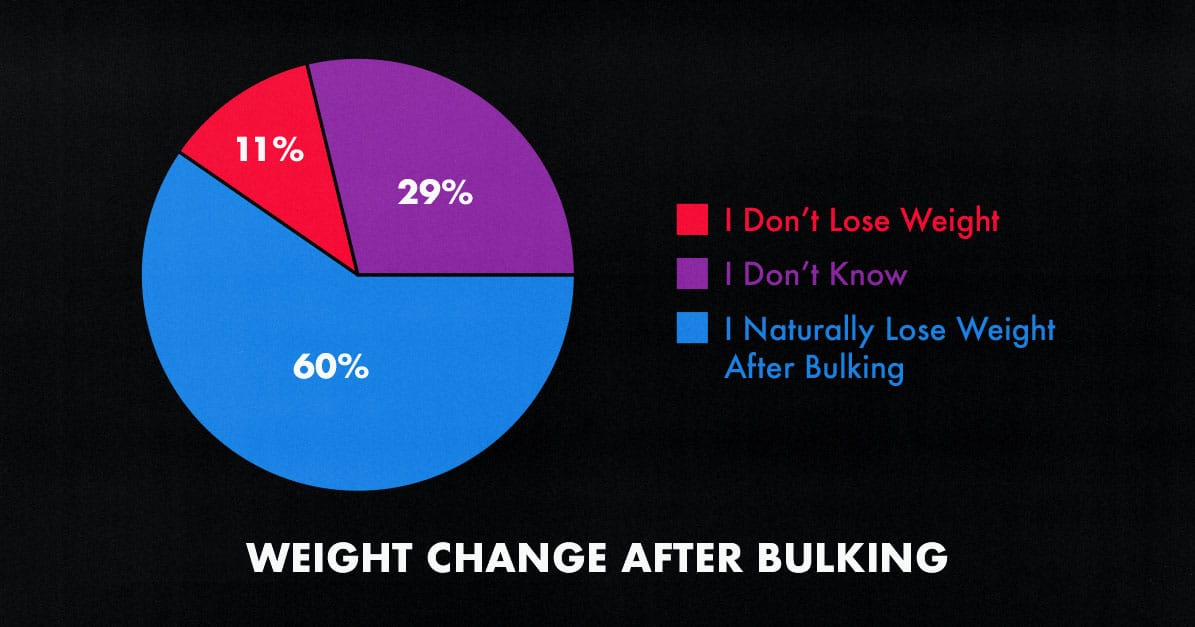
When we surveyed our readers, 60% said that after they finished bulking, they tended to lose weight. 58% said that after bulking, they were eager to go back to eating less food. I can definitely relate. I’m the same way. But if we back down from overeating, won’t we lose what we fought so hard to gain?
How to Maintain Your Gains After Bulking
If you keep lifting weights, eating well, and living a healthy lifestyle, your body will gladly hold onto the muscle you’ve built. It will get the missing energy from your body fat instead. And chances are, if you’ve just finished bulking, you’ve got some spare body fat you can feed into the furnace.
If you let your weight drift back down, you’ll lean back out, your metabolism will slow down, and you’ll get back on good terms with your appetite. Perhaps most importantly, you’ll keep all your muscle.
Maintenance Training
You don’t need to change your workout routine. In fact, if you have a bit of extra body fat, you may be able to use that body fat to fuel muscle and strength gains. Remember, guys at higher body fat percentages tend to have an easier time achieving body recomposition (full explanation). So keep trying to get stronger. Keep striving for progressive overload.
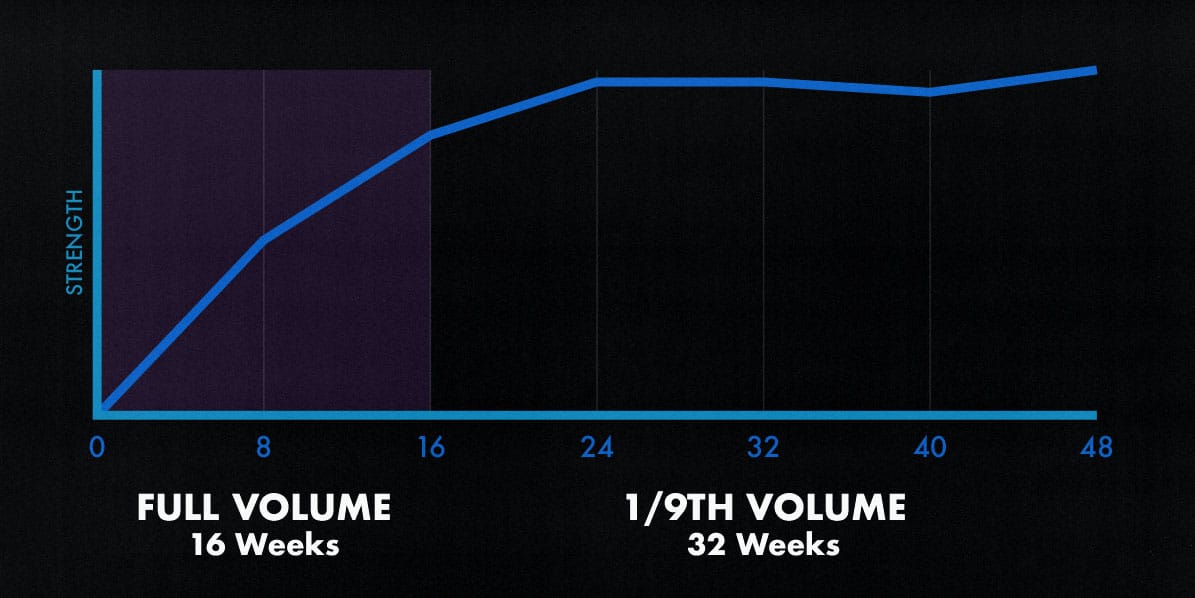
On the other hand, you don’t need to keep training as hard or as often. In a study by Bickel and colleagues, the participants followed a muscle-building workout routine for 16 weeks, then went into a low-volume maintenance phase (study). After those 32 weeks, the participants gained a little bit of strength. The older lifters (60–75) maintained their strength with 1/3 of their original training volume.
A good rule of thumb is to count each hard set as one unit of volume. If you were doing 15 sets per muscle group per week to build muscle, you can probably maintain your gains with as few as 2 sets per muscle group. This holds true even if you’re slowly losing weight (study).
Putting that into practice, you could do the big compound lifts once or twice per week. For example, you could squat, deadlift, press, and pull every Monday and Thursday, doing 2–4 sets per exercise per workout. If you get within a few reps of failure, that’s enough muscle stimulation to maintain your size and strength. It’s also enough to meet the minimum health recommendations for resistance training (study, Harvard).
These are the minimum volume recommendations. Feel free to do more. You can keep doing your favourite isolation lifts, keep trying to bring up lagging muscle groups, or work on getting stronger. Less is enough, but more can be better.
Fight to maintain at least 90% of your strength on the big compound lifts. If you start suffering from progressive underload, add some extra sets in.
Bonus: consider lifting in a higher rep range. When I’m bulking, I’ll do anywhere from 4–20 reps per set. When I’m reverse bulking, I do more like 12–30 reps per set. Here’s why:
- High-rep sets cause cardiovascular adaptations in your muscles. This improves blood flow to your muscles, improving your ability to bulk them up in the future (study). These adaptations aren’t as dependent on a calorie surplus (article).
- High-rep sets don’t need as many warm-up sets. The first 10 reps of a 20-rep set will help warm you up. If you’re limber, that may be all you need.
Maintenance Diet
When you finish your bulk, keep the healthy habits and drop the others. If you’ve been having a nutritious smoothie every morning, there’s no reason to stop now. That habit suits our body type whether we’re bulking or not. But if you’ve been chugging weight-gainer shakes, you may want to get back to eating whole foods.
- Listen to your appetite. If you aren’t hungry, you don’t need to eat. If you are hungry, eat more.
- Keep eating balanced meals that contain a nice mix of protein, carbs, fat, fibre, and micronutrients.
- Keep prioritizing nutritious whole foods over processed foods.
- Eat as many meals and snacks as you want. Find a rhythm that suits you. Keep your eating schedule relatively constant from day to day.
- You can stop using muscle-building supplements (though you may want to continue taking creatine).
- It’s okay if you start eating less protein, fat, or carbs. With that said, if you want to increase your likelihood of building muscle, you could keep trying to eat at least 0.7 grams of protein per pound bodyweight per day (study).
- It’s okay to eat smaller meals.
Maintenance Lifestyle
Almost all of the lifestyle changes we make while bulking are good ones. Keep exercising, go to bed on time most nights, and don’t let vices derail your life. We all struggle to keep different vices at bay. I’m sure you know what yours are. Now isn’t the time to let them encroach into your lifestyle.
Also, as mentioned above, cardiovascular adaptations aren’t as dependent on a calorie surplus as muscle-building adaptations. If you want to improve your cardiovascular fitness, now’s a great time to work on those goals.

Frequently Asked Questions
What’s the Difference Between Reverse Bulking & Cutting?
Reverse bulking and cutting are similar. You’re losing weight, burning fat, and keeping your muscles. Both methods involve lifting weights, eating a good diet, and gradually losing weight. But there’s a key difference.
- Cutting is when you force your weight down, even when it’s uncomfortable. You aren’t listening to your appetite. You aren’t trying to settle into a comfortable body weight.
- Reverse bulking is when you start listening to your appetite again. You let your calorie intake wander where it will, inevitably resulting in some weight loss. You aren’t forcing fat loss, you’re allowing fat loss.
What if You Lose 2–4 Pounds in a Single Week?
When you ease back on your bulking diet, you won’t have as much food winding its way through your digestive system. You won’t hold onto as much fluid. Your muscles won’t be as packed full of glycogen. It’s normal to flush out a few pounds, especially during the first week or two. Don’t panic. You aren’t losing muscle.
Is it Okay to Lose Strength?
Bulking diets are performance-enhancing. They flood you with energy and pack your muscles full of glycogen. When you stop eating so abundantly, it’s normal for your performance to go down in the gym. You might lose some reps on your lifts. That’s okay. As a rule of thumb, try to maintain at least 90% of your strength.
During my most recent bulk, I worked up to benching 225 for 15 reps per set. When I switched to reverse bulking, that went down to 12 reps per set. That doesn’t worry me. As soon as I go back to eating more, that strength will return.
You may have the opposite experience. If you keep training hard, you might gain strength, burning fat while building muscle. This is more common in people with hearty appetites. I don’t have one of those.
Is it Normal to Get Smaller?
It’s normal to get a bit smaller when reverse bulking. You’re sort of losing muscle, but not really. You aren’t losing contractile tissue, just glycogen. Your muscles aren’t packed full of as much water and sugar. You’re like a Ferrari that weighs less because it has less fuel in the tank. That’s not exactly a good thing, but some boons are only available while bulking.

How Much Weight Will You Lose?
When you reverse bulk, it’s common to lose around 10 pounds before settling into a comfortable new body weight. You may lose more or less. It all depends on how much weight you gained and how big your appetite is.
During my first bulk, I went from 130 to 150 pounds, moving from underweight to normal weight. I maintained all my muscle mass by doing two quick bodyweight workouts every week while eating a decent diet. I was still quite thin. My body clutched desperately at what little I’d given it.
During my last bulk, I climbed from 185 up to 205 pounds, popping me temporarily into the overweight category. After a few months of reverse bulking, I settled at 190 pounds, which feels great. My shirts don’t fit as snuggly anymore, but I have little use for them anyway.
Remember, you aren’t losing muscle; you’re just losing fat, gut contents, and glycogen. Your weight is going down on the scale, but that’s fine. I know it can seem like you’re moving backwards, but bulking is about gaining weight to facilitate muscle growth. The point isn’t to gain weight, it’s to build muscle. If you lose weight while maintaining your muscle mass, that’s great.
The End is the Beginning
At a certain point, your weight will settle. You’ll be in better shape than ever, you’ll have dropped down to a more natural body-fat percentage, and you’ll be on good terms with your appetite again. At that point, you can easily maintain your gains, provided you keep living a healthy lifestyle. A healthy lifestyle involves resistance training, being active, eating a good diet, avoiding vices, and getting enough sleep. All good things.
Perhaps not so long from now, when you’re lean and hungry again, you’ll decide to build more muscle. Your next bulk will be there waiting for you with open arms and an eager belly.

Alright, that’s it for now. If you want to know all the ins and outs of building muscle, we have a free newsletter. If you want a full foundational bulking program, including a 5-month full-body workout routine, gain-easy diet guide, recipe book, and online coaching, check out our Bony to Beastly Bulking Program. Or, if you want a customizable intermediate bulking program, check out our Outlift Program.
Shane Duquette is the founder of Outlift, Bony to Beastly, and Bony to Bombshell, each with millions of readers. He's a Certified Conditioning Coach (CCC), has gained 70 pounds, and has over a decade of experience helping more than 15,000 people build muscle. He also has a degree in fine arts, but those are inversely correlated with muscle growth.
